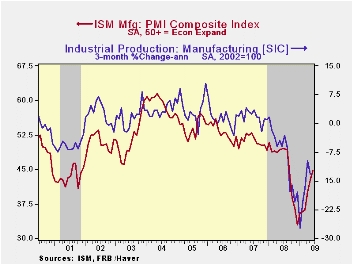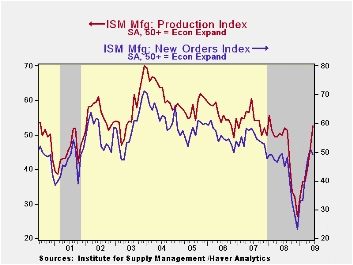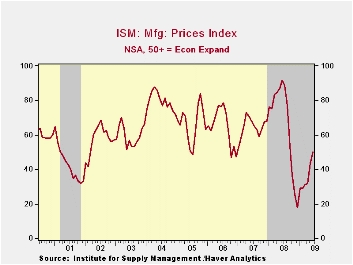 Global| Jul 01 2009
Global| Jul 01 2009ISM Factory Sector Index Rose Modestly While Prices Jump
by:Tom Moeller
|in:Economy in Brief
Summary
The National Association of Purchasing Management indicated that the recession in factory sector continued to moderate last month. The June composite index for the factory sector rose to 44.8 from 42.8 in May. Though the latest figure [...]

The National Association of Purchasing Management indicated that the recession in factory sector continued to moderate last month. The June composite index for the factory sector rose to 44.8 from 42.8 in May. Though the latest figure still indicates a lower level of activity, as does any below the break-even point of 50, the rate of decline appears to be easing. The worst of the decline was at yearend '08 when the index touched 32.9. The latest figure about matched Consensus expectations.
 Improvement in the components of the overall June ISM index
was broad-based. The production component pushed through the break-even
point for the first time since last summer with a rise to 52.5, up off
the low of 26.3 in December. During the last ten years there has been
an 84% correlation between the level of the production component of the
composite index and the three-month growth in factory sector industrial
production. It is appropriate to correlate the ISM index level
with factory sector output growth because the ISM
index is a diffusion index. It measures growth by using all of the
positive changes in activity added to one half of the zero change in
activity measures. The speed of supplier deliveries also
slowed for the third consecutive month.
Improvement in the components of the overall June ISM index
was broad-based. The production component pushed through the break-even
point for the first time since last summer with a rise to 52.5, up off
the low of 26.3 in December. During the last ten years there has been
an 84% correlation between the level of the production component of the
composite index and the three-month growth in factory sector industrial
production. It is appropriate to correlate the ISM index level
with factory sector output growth because the ISM
index is a diffusion index. It measures growth by using all of the
positive changes in activity added to one half of the zero change in
activity measures. The speed of supplier deliveries also
slowed for the third consecutive month.
 Importantly, the employment index rose to its highest level
(40.7) since last September and it was up from the February low of
26.1. During the last ten years there has been an 89% correlation
between the index level and the one-month change in manufacturing
payrolls. The new orders figure retraced slightly its earlier
improvement with a decline to slightly below the break-even level of
50. Nevertheless, it remained near the highest level since last August
and up from the December low of 23.1. The export order index improved
further to 49.5 versus the December reading of 35.5. During the last
ten years there has been a 53% correlation between the index and the
q/q change in real exports of goods in the GDP accounts. The rate of
inventory destocking picked up as evidenced by a low reading of 30.8
which was the lowest level since 1982.
Importantly, the employment index rose to its highest level
(40.7) since last September and it was up from the February low of
26.1. During the last ten years there has been an 89% correlation
between the index level and the one-month change in manufacturing
payrolls. The new orders figure retraced slightly its earlier
improvement with a decline to slightly below the break-even level of
50. Nevertheless, it remained near the highest level since last August
and up from the December low of 23.1. The export order index improved
further to 49.5 versus the December reading of 35.5. During the last
ten years there has been a 53% correlation between the index and the
q/q change in real exports of goods in the GDP accounts. The rate of
inventory destocking picked up as evidenced by a low reading of 30.8
which was the lowest level since 1982.
The separate index of prices paid again rose sharply with improved activity levels. The reading at the break-even level of 50 was its highest since last September and it's up from the December low of 18.0. During the last twenty years there has been a 79% correlation between the price index and the three-month change in the PPI for intermediate goods.
| ISM Mfg | June | May | June '08 | 2008 | 2007 | 2006 |
|---|---|---|---|---|---|---|
| Composite Index | 44.8 | 42.8 | 49.5 | 45.5 | 51.1 | 53.1 |
| New Orders Index | 49.2 | 51.1 | 49.3 | 42.1 | 54.3 | 55.4 |
| Employment Index | 40.7 | 34.3 | 44.1 | 43.2 | 50.5 | 51.7 |
| Prices Paid Index (NSA) | 50.0 | 43.5 | 91.5 | 66.5 | 64.6 | 65.0 |
Tom Moeller
AuthorMore in Author Profile »Prior to joining Haver Analytics in 2000, Mr. Moeller worked as the Economist at Chancellor Capital Management from 1985 to 1999. There, he developed comprehensive economic forecasts and interpreted economic data for equity and fixed income portfolio managers. Also at Chancellor, Mr. Moeller worked as an equity analyst and was responsible for researching and rating companies in the economically sensitive automobile and housing industries for investment in Chancellor’s equity portfolio. Prior to joining Chancellor, Mr. Moeller was an Economist at Citibank from 1979 to 1984. He also analyzed pricing behavior in the metals industry for the Council on Wage and Price Stability in Washington, D.C. In 1999, Mr. Moeller received the award for most accurate forecast from the Forecasters' Club of New York. From 1990 to 1992 he was President of the New York Association for Business Economists. Mr. Moeller earned an M.B.A. in Finance from Fordham University, where he graduated in 1987. He holds a Bachelor of Arts in Economics from George Washington University.






